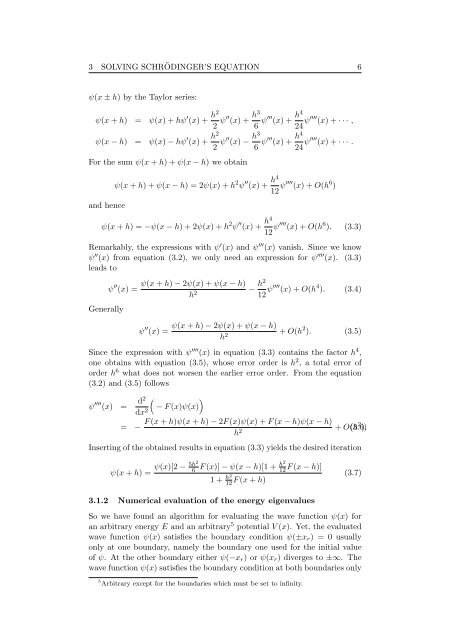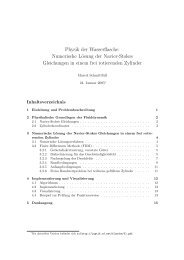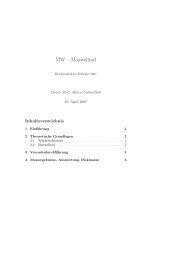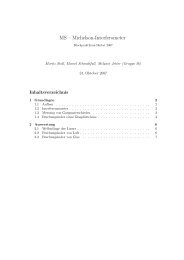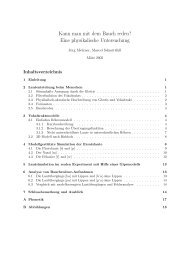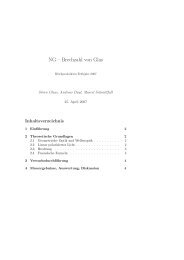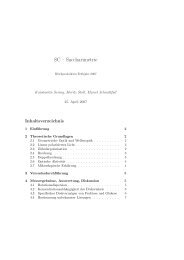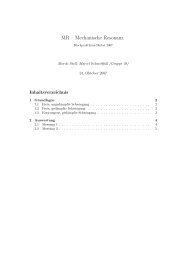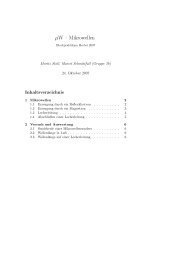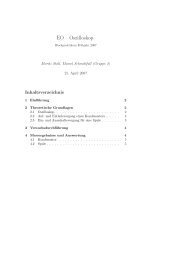JavaPsi - Simulating and Visualizing Quantum Mechanics (english)
JavaPsi - Simulating and Visualizing Quantum Mechanics (english)
JavaPsi - Simulating and Visualizing Quantum Mechanics (english)
You also want an ePaper? Increase the reach of your titles
YUMPU automatically turns print PDFs into web optimized ePapers that Google loves.
3 SOLVING SCHRÖDINGER’S EQUATION 6<br />
ψ(x ± h) by the Taylor series:<br />
ψ(x + h) = ψ(x) + hψ ′ (x) + h2<br />
2 ψ′′ (x) + h3<br />
6 ψ′′′ (x) + h4<br />
24 ψ′′′′ (x) + · · · ,<br />
ψ(x − h) = ψ(x) − hψ ′ (x) + h2<br />
2 ψ′′ (x) − h3<br />
6 ψ′′′ (x) + h4<br />
24 ψ′′′′ (x) + · · · .<br />
For the sum ψ(x + h) + ψ(x − h) we obtain<br />
<strong>and</strong> hence<br />
ψ(x + h) + ψ(x − h) = 2ψ(x) + h 2 ψ ′′ (x) + h4<br />
12 ψ′′′′ (x) + O(h 6 )<br />
ψ(x + h) = −ψ(x − h) + 2ψ(x) + h 2 ψ ′′ (x) + h4<br />
12 ψ′′′′ (x) + O(h 6 ). (3.3)<br />
Remarkably, the expressions with ψ ′ (x) <strong>and</strong> ψ ′′′ (x) vanish. Since we know<br />
ψ ′′ (x) from equation (3.2), we only need an expression for ψ ′′′′ (x). (3.3)<br />
leads to<br />
ψ ′′ (x) =<br />
Generally<br />
ψ(x + h) − 2ψ(x) + ψ(x − h)<br />
h 2<br />
ψ ′′ (x) =<br />
− h2<br />
12 ψ′′′′ (x) + O(h 4 ). (3.4)<br />
ψ(x + h) − 2ψ(x) + ψ(x − h)<br />
h 2 + O(h 2 ). (3.5)<br />
Since the expression with ψ ′′′′ (x) in equation (3.3) contains the factor h 4 ,<br />
one obtains with equation (3.5), whose error order is h 2 , a total error of<br />
order h 6 what does not worsen the earlier error order. From the equation<br />
(3.2) <strong>and</strong> (3.5) follows<br />
ψ ′′′′ (x) = d2<br />
dx2 <br />
<br />
− F (x)ψ(x)<br />
F (x + h)ψ(x + h) − 2F (x)ψ(x) + F (x − h)ψ(x − h)<br />
= −<br />
h2 + O(h 2 (3.6) ).<br />
Inserting of the obtained results in equation (3.3) yields the desired iteration<br />
ψ(x + h) =<br />
ψ(x)[2 − 5h2<br />
6<br />
h2<br />
F (x)] − ψ(x − h)[1 + 12 F (x − h)]<br />
1 + h2<br />
12 F (x + h)<br />
3.1.2 Numerical evaluation of the energy eigenvalues<br />
(3.7)<br />
So we have found an algorithm for evaluating the wave function ψ(x) for<br />
an arbitrary energy E <strong>and</strong> an arbitrary 5 potential V (x). Yet, the evaluated<br />
wave function ψ(x) satisfies the boundary condition ψ(±xr) = 0 usually<br />
only at one boundary, namely the boundary one used for the initial value<br />
of ψ. At the other boundary either ψ(−xr) or ψ(xr) diverges to ±∞. The<br />
wave function ψ(x) satisfies the boundary condition at both boundaries only<br />
5 Arbitrary except for the boundaries which must be set to infinity.


